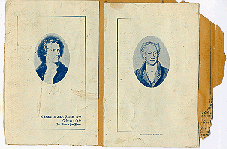 Previous
Previous
EXHIBIT: Cultural Conflict and Acculturation

 Previous Previous
|
EXHIBIT: Cultural Conflict and Acculturation |
Next
|
 Program for the 150th Geburstagfest fur Goethe. |
After the Civil War, English conversation became common among the German clubs in Indianapolis. While there is no doubt that the German language was still widely used, English became prevalent. The Germans had become used to the language through their English-speaking neighbors, but they simply had been speaking the language they knew best. Though they had been using a different tongue as their medium of expression, the Freie Presse had argued long before the war that the Germans in Indianapolis had no desire to establish a different nationality in America; on the contrary, they had determined to become Americans the day they set foot on the plank of the vessel sailing for [American] shores. During the late 1860s the Germans began breaking the language barrier, which had prevented free social intercourse with the rest of the community. . . .
It is correct to say that the Indianapolis Germans attempted to preserve their native tongue even in the face of opposition. The clubs and churches strongly resisted attempts to change their language to English, and in 1909 the city grade school had 633 teachers, forty-three of whom taught German under the law of 1869 [—a law which authorized instruction in the German language wherever the parents of twenty-five pupils petitioned for it]. . . .
And then there were, of course, the traditional mainstays of instruction in German, the parochial schools under the auspices of the Lutheran, Reformed, and Roman Catholic churches which continued the use of German in the classroom along with English.
But the German element was not merely concerned over the preservation of the German language as such. The language was also a symbol of their different philosophy of life, and in this period it helped to identify those who accepted similar ideals. In general, German-Americans tended to regard their culture as being superior to the native culture, and many of them were willing to spare no effort for the preservation of their way of life within our multi-ethnic American society—for themselves and for their children.

|
HOME | EXHIBIT | EXPLORE | EXAMINE | ABOUT | OTHER | SEARCH |

|
|
Updated: 29 April 2004, RKB Comments: speccoll@iupui.edu URL: http://www.ulib.iupui.edu/special/digproj/circle/exhibit5_5.html Copyright © 1998-2004 - The Trustees of Indiana University |
Ruth Lilly Special Collections and Archives IUPUI University Library 755 W. Michigan St. Indianapolis, IN 46202 (317) 274-0464 |